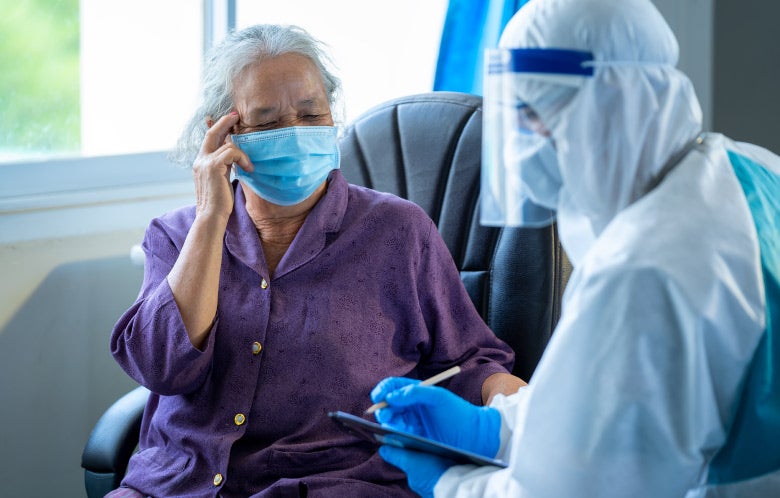To quote President Biden, “This is not March of 2020… we know more.” It's been nearly two years since we first dedicated an EBM Focus to COVID with COVID-19: Ten Things You Need to Know. Reflecting on the questions we asked in that first edition, “Is ibuprofen safe to use during COVID-19 infection?”, and even questions in the second article, Ten Things You Need to Know NOW, “Are supplements helpful in preventing COVID-19 infection or reducing severity?”, it's clear that we really have come a long way. We are entering the third year of the COVID-19 pandemic with vaccines, treatments, and yes, new variants. In the spirit of evidence-informed decision making and squashing misinformation, allow us to present the 2022 edition of Ten Things You Need to Know Now.
1. How contagious is Omicron?
Two to three times as contagious as Delta. In a world ready to realize an endgame for this pandemic, this new variant has raised concerns about increased transmissibility and decreased vaccine efficacy (not to mention the uncertainty over how to pronounce its name). Omicron has dozens of mutations in the spike protein, the target of monoclonal antibodies and existing vaccines. Researchers postulate the mutations occurred in a single immunocompromised host over a period of about 10 months, rather than a single strain that accumulated the mutations over subsequent transmissions. Early studies from households and contacts (unadjusted for prior vaccination or infection) show that 19 percent of Omicron index cases resulted in a secondary household case compared to eight percent with Delta (adjusted odds ratio 3.2 [95%CI 2.0-5.0, p <0.001]). Oh, and apparently it’s equally acceptable to pronounce it “AH-muh-kraan” or “OH-muh-kraan”.
2. Are vaccines still effective against Omicron?
Yes — if you are boosted after a primary vaccine series. An early non-peer reviewed case-control study of vaccine effectiveness in 581 people with Omicron demonstrated 70-75 percent effectiveness against symptomatic infection in boosted patients compared to only 30 percent in those who had only completed a primary (2-dose) vaccine course. Importantly however, two doses of the Pfizer vaccine still provided 70 percent protection against severe disease requiring hospitalization. Patients studied had completed either a Pfizer or AstraZeneca primary vaccine series, but all booster doses were Pfizer. While overall vaccine effectiveness against Omicron appears to be significantly lower than effectiveness against Delta based on these early data, 75 percent is still considered a “moderate to high” vaccine effectiveness so we should still be trying to get as many people boosted as possible. Lab data from Moderna and Johnson & Johnson report similar news about effectiveness against Omicron, but clinical reports are still pending for those vaccines.
3. Should we recommend mix-and-match boosting?
Maybe. While it is now clear that none of the vaccines provide lifelong immunity against all COVID variants, mRNA vaccines may be more nimble to produce and potentially more efficacious in the long run. One interesting pragmatic world-wide experiment happening now is the large number of people initially vaccinated with one vaccine but boosted with another. Epidemiologists call this “heterologous mixing” of vaccines. Theoretical benefits may include exposure to different antigens or activation of different parts of the immune system, while harms might include different potential side effects and lack of clarity in public health messaging. Mixing is happening out of necessity in some settings, but also as part of clinical trials. Initial results coming in seem to favor heterologous boosting, but we need more long-term data to make any conclusions.
4. Can you give flu and COVID vaccines together?
Yes, definitely. Initially, the CDC recommended spacing flu and COVID-19 vaccines by at least 14 days due to lack of data and to prevent false attribution of side-effects to COVID-19 vaccines, but evidence now supports concomitant vaccination as standard practice. A multicentered randomized trial in the UK evaluated concomitant administration of two COVID-19 vaccines (Pfizer and AstraZeneca) with three inactivated influenza vaccines. Results from participant diaries showed that systemic reactions were similarly common between groups. Immune response (as measured by SARS-CoV-2 spike protein antibody and hemagglutinin antibody inhibition) to both COVID-19 and influenza vaccination, respectively, was preserved. The bottom line is that concomitant administration of COVID-19 and influenza vaccines produced similar side effects without altering immune response and not only protects against infection but reduces the burden on the healthcare system.
5. Should COVID-19 vaccination be given during pregnancy?
Yes. Numerous organizations including the CDC and American College of Obstetricians and Gynecologists (ACOG) currently recommend COVID-19 vaccination, including booster doses, for pregnant and lactating individuals. From cohort studies, it appears vaccines are safe and effective in preventing infection. For more information, see the topic COVID-19 and Pregnant Patients in DynaMed.
6. How reliable are home antigen tests?
The news is not great. With many governments offering free home COVID tests, we’d like to think the tests are providing good information. A 2020 study comparing various self-collected RT-PCR-based tests to rapid antigen tests found that detection rates were 51 to 82 percent for molecular diagnostic tests compared to 12 percent for rapid antigen tests. All performed better within nine days of symptom onset compared to later or in asymptomatic people. The glass is a little more full based on a 2021 Cochrane review of 48 studies evaluating commercial antigen tests which demonstrated a sensitivity of 69 percent (95% CI 62%-75%) and specificity of 99.6 percent (95% CI 99%-99.8%). Recommendations at present primarily reflect a need for confirmatory testing when antigen tests are positive and quarantining anyway if antigen tests are negative. Somewhat related, when it comes to RT-PCR testing, emerging data suggest saliva swabs may perform better than mid-turbinate swabs for detection of Omicron.
7. How well does the antiviral molnupiravir work?
It seems to work pretty well, at least against Delta. The oral antiviral drug molnupiravir received an FDA emergency use authorization for at-risk adult patients with mild-to-moderate COVID-19, with intended initiation within five days after the onset of symptoms. The MOVe-OUT trial, conducted between May and November 2021, randomized 1,433 non-hospitalized and unvaccinated adults with mild-to-moderate COVID-19 and at least one risk factor for severe illness to either molnupiravir (800 mg twice daily) or placebo for five days, starting within five days after symptom onset. During a planned interim analysis performed when 50 percent of the patients had been followed for 29 days, molnupiravir significantly decreased the risk of death or hospitalization for any cause compared with the placebo group (7.3% vs. 14.1%, p = 0.001). Molnupiravir is not considered safe for children or pregnant women based on animal studies.
8. What is the latest on remdesivir?
The remdesivir rollercoaster continues, but the drug may prove to be helpful in the end. Results of the WHO SOLIDARITY trial were disappointing, as remdesivir did not improve survival when added to the standard of care for hospitalized patients. In two meta-analyses, remdesivir appeared to reduce the need for mechanical ventilation for patients admitted on oxygen therapy. Most recently, however, three days of remdesivir among outpatients with mild-to-moderate COVID-19 reduced the composite of hospitalization or death, although no one actually died during the 28-day study period. So all in all, the data on remdesivir are looking hopeful in regard to preventing hospitalization and more severe disease courses.
9. Is fluvoxamine really a potential treatment option for patients with COVID-19?
So far, it seems like we should stick to using fluvoxamine for obsessive-compulsive disorder (OCD). The largest study (TOGETHER trial) evaluated fluvoxamine in people with symptomatic COVID-19 at higher risk of developing a severe disease. In Brazil, 1,497 adults were randomized to either fluvoxamine (200 mg per day) or a placebo for 10 days. Fluvoxamine was associated with a lower risk of the composite outcome of retention in an emergency setting or transfer to a tertiary hospital (11 percent versus 16 percent). However, the risk of both hospitalization for COVID-19 or death did not differ significantly between the two groups. The Infectious Disease Society of America (IDSA) currently recommends that fluvoxamine should only be considered for non-hospitalized patients in the context of a clinical trial.
10. Lastly, what do we know about Long COVID?
Long COVID is a heterogenous group of more than 50 conditions and symptoms united by a preceding COVID infection, but otherwise poorly defined. The WHO seems to be leaning towards defining Long COVID as symptoms that persist one-three months after a known infection and “post-COVID” as symptoms lasting longer than three months. At this point, while it is clear that although almost the entire human population has suffered mentally, people who have had COVID will also often have objectively measurable sequelae including decreased cardiac function on echo, lung scarring on CT and visible brain changes on MRI (probably contributing to the three most common symptoms: fatigue, dyspnea, and cognitive changes). Furthermore, although there is some correlation between severity of the initial infection and long-term symptoms, many of the sufferers of long COVID are young, previously healthy and experienced mild or even asymptomatic initial infections. More answers may be provided in 2022, but Long COVID seems both common and serious, another potential advantage of vaccinations over treatment.



